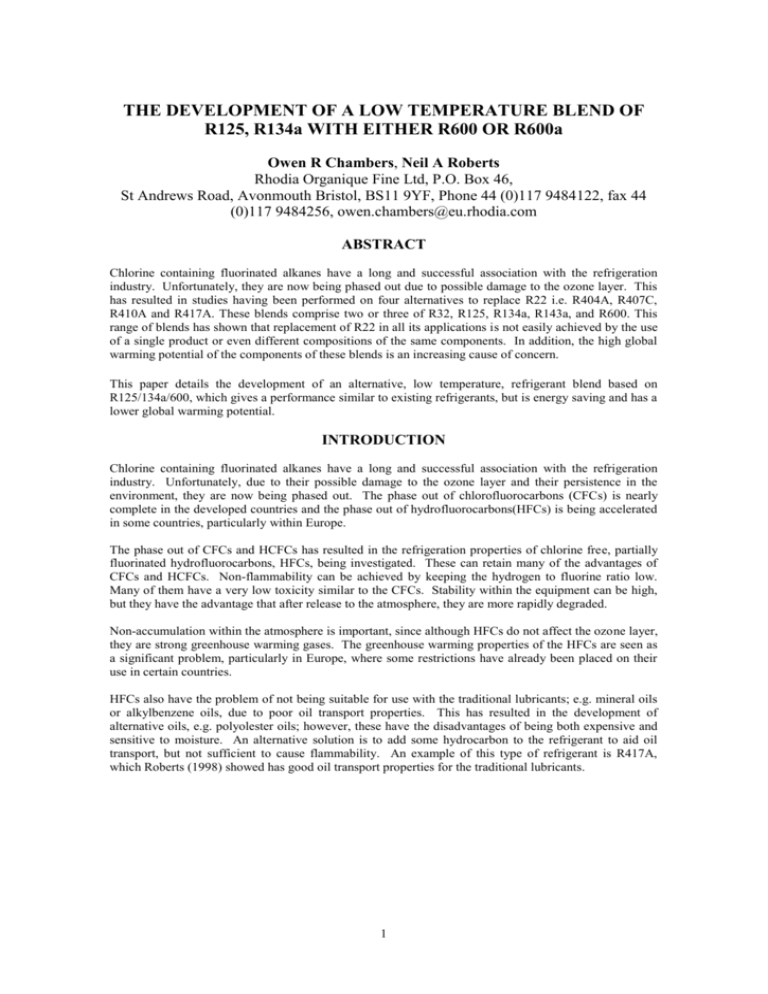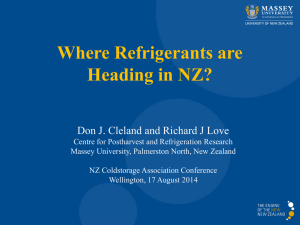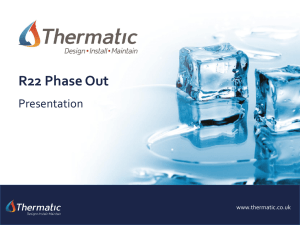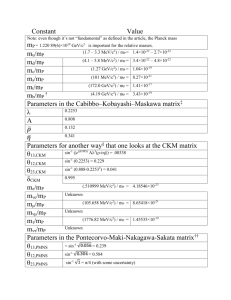The development of a low temperature blend of R125, R134a with
advertisement

THE DEVELOPMENT OF A LOW TEMPERATURE BLEND OF R125, R134a WITH EITHER R600 OR R600a Owen R Chambers, Neil A Roberts Rhodia Organique Fine Ltd, P.O. Box 46, St Andrews Road, Avonmouth Bristol, BS11 9YF, Phone 44 (0)117 9484122, fax 44 (0)117 9484256, owen.chambers@eu.rhodia.com ABSTRACT Chlorine containing fluorinated alkanes have a long and successful association with the refrigeration industry. Unfortunately, they are now being phased out due to possible damage to the ozone layer. This has resulted in studies having been performed on four alternatives to replace R22 i.e. R404A, R407C, R410A and R417A. These blends comprise two or three of R32, R125, R134a, R143a, and R600. This range of blends has shown that replacement of R22 in all its applications is not easily achieved by the use of a single product or even different compositions of the same components. In addition, the high global warming potential of the components of these blends is an increasing cause of concern. This paper details the development of an alternative, low temperature, refrigerant blend based on R125/134a/600, which gives a performance similar to existing refrigerants, but is energy saving and has a lower global warming potential. INTRODUCTION Chlorine containing fluorinated alkanes have a long and successful association with the refrigeration industry. Unfortunately, due to their possible damage to the ozone layer and their persistence in the environment, they are now being phased out. The phase out of chlorofluorocarbons (CFCs) is nearly complete in the developed countries and the phase out of hydrofluorocarbons(HFCs) is being accelerated in some countries, particularly within Europe. The phase out of CFCs and HCFCs has resulted in the refrigeration properties of chlorine free, partially fluorinated hydrofluorocarbons, HFCs, being investigated. These can retain many of the advantages of CFCs and HCFCs. Non-flammability can be achieved by keeping the hydrogen to fluorine ratio low. Many of them have a very low toxicity similar to the CFCs. Stability within the equipment can be high, but they have the advantage that after release to the atmosphere, they are more rapidly degraded. Non-accumulation within the atmosphere is important, since although HFCs do not affect the ozone layer, they are strong greenhouse warming gases. The greenhouse warming properties of the HFCs are seen as a significant problem, particularly in Europe, where some restrictions have already been placed on their use in certain countries. HFCs also have the problem of not being suitable for use with the traditional lubricants; e.g. mineral oils or alkylbenzene oils, due to poor oil transport properties. This has resulted in the development of alternative oils, e.g. polyolester oils; however, these have the disadvantages of being both expensive and sensitive to moisture. An alternative solution is to add some hydrocarbon to the refrigerant to aid oil transport, but not sufficient to cause flammability. An example of this type of refrigerant is R417A, which Roberts (1998) showed has good oil transport properties for the traditional lubricants. 1 A widely used HCFC is chlorodifluoromethane, R22. This is very popular for low temperature work in commercial and domestic freezers, cold stores etc. It is also widely used in some higher temperature units, such as small air conditioning units and water chillers. Formerly, it was also used in the azeotropic blend, R502, which is an azeotrope of R115 with R22 (R115/22 51.2/48.8). This refrigerant was particularly attractive in low temperature situations, where R22 or R12 were reaching their effective working limits. However, since R502 contains R115, which is a strong ozone depleter, it is now no longer available for use. Currently, there are available several HFC blends to meet the requirements of R22. For use in commercial and domestic freezers and for air conditioning units R407C and R417A are used. The former has the disadvantage of not being suitable with mineral or alkylbenzene oils and neither is suitable for the very low temperatures, where R502 is utilised. The present substitutes for R502 are R404A (R125/143a/134a, 44/52/4), R507A (R125/143a, 50/50) or R22. The problem with the first two is that they have very high global warming potentials (GWPs) due to the R143a content. At low temperatures, R22 has a poor capacity and, in addition, is an ozone depleter and will eventually be phased out. The concept of global warming potential (GWP) has been developed to compare the ability of a greenhouse gas to trap heat in the atmosphere relative to carbon dioxide and is, hence, given as a dimensionless number. The global warming potentials for gases quoted are given in IPCC (1996) for the 100 year time horizons. There is a later report, IPCC (2001), but the earlier one was that used in the Kyoto protocol and is hence used here. R507 has a GWP of 3300 and R404A is only slightly less at 3260. These high GWPs are due to the main component, R143a (CF3CH3), which has a GWP of 3800. In contrast, the GWPs of R125 and R134a are 2800 and 1300 respectively. A blend based on the latter two compounds will thus have a lower GWP than R404A or R507. DEVELOPMENT AND TESTING OF A NEW REFRIGERANT A program of work has, therefore been carried out looking at the performance of refrigerant blends based on R417A (R125/134a/600a 46.6/50.0/3.4), but utilising higher proportions of R125 relative to R134a. Their performance was compared to that of R22, R404A and R407C. The target of this work was to look for a refrigerant suitable for low temperature applications, where previously R502 had been used and also one suitable for water chillers, where R22 is used. The work consists of three parts: firstly the determination of the vapour pressure/temperature relationship of the blends to be tested, secondly, to compare their cooling duty with R404A and R22 on the low temperature (LT) calorimeter and finally to trial the proposed blend in an industrial unit. The compositions of the refrigerants tested are given in Table 1. Table 1 Details of the refrigerants tested in this study Number Name in text composition 3 85% R125 R-125/134a/600 (85.1/11.5/3.5) 4 R407C R-32/R125/R134a (23.0/25.0/52.0) 5 R404A R-125/R143a/R134a (44.1/51.9/4.0) 6 R22 Comments: The refrigerant compositions and nomenclature are based on that of ASHRAE. In the listing under composition the most volatile component is given first. The numbers following the components are the composition in %w/w. The key to the refrigerant nomenclature is as follows: R-125 pentafluoroethane, R-134a 1,1,1,2tetrafluoroethane, R-600 n-butane, R600a isobutane, R-32 difluoromethane, R-143a 1,1,1trifluoroethane. 2 1 Saturated Vapour Pressure Measurements The equipment used for determining the vapour pressure/temperature relationship consisted of a 1 litre Parr reactor immersed completely in a thermostatically controlled water bath. The bath temperature was measured using a calibrated platinum resistance thermometer. The pressure was read with a calibrated pressure transducer with an experimental accuracy of 0.01bara. To carry out the vapour pressure measurements, approximately 1.2kg of the refrigerant was charged into the Parr reactor. The reactor was then cooled overnight. When it had reached temperature, the pressure and temperatures were recorded every ten minutes until constant. Since the recorded temperatures and pressures apply to a mainly condensed system then these approximately correspond to the bubble point. These results can now be used to plot a graph of the reciprocal of the temperature against the natural logarithm of the pressure, which give nearly straight lines (correlation factors were extremely high, R2>0.9999). These linear equations can now be used to predict the pressure at any required temperature. The data obtained does not give the dew point and hence does not give the glide. An approximate evaluation of the glide can be obtained using a modified REFPROP 6 database (1998) and the LJ1 model, Lemmon (1996). The standard REFPROP 6 database contains only binary interaction parameters for R125/600. In the modified version of REFPROP 6, binary interaction parameters determined by Roberts and Jawad (2000) were incorporated and used to determine the glide. 2 Determination of the performance of the refrigerants The performances of the refrigerants were determined on a low temperature (LT) calorimeter. The LT calorimeter was built in house using a Bitzer semi-hermetic condensing unit containing Shell SD oil. The hot vapour from the compressor passed, through an oil separator and into the condenser. The discharge pressure at the exit of the compressor was kept constant by the means of a packed gland shut-off valve. The refrigerant then travelled along the liquid line to the evaporator. The evaporator was constructed from 15mm Cu tubing coiled around the edges of a well-insulated 32litre SS bath. The bath was filled with 50:50 glycol:water solution and heat was supplied to it by 3x1kW heaters controlled by a PID controller. A stirrer with a large paddle ensured that the heat was evenly distributed. The evaporating pressure was controlled by an automatic expansion valve. The refrigerant vapour returned to the compressor through a suction line heat exchanger. Twelve temperature readings, five pressure readings, compressor power and heat input were all recorded digitally. The tests were run at a condensing temperature of 40 oC and an evaporator superheat of 8oC (±0.5oC). For R22 the temperature at the end of the evaporator was maintained at 8 oC above the temperature equivalent to the evaporating pressure. For the other refrigerants the temperature at the end of the evaporator was maintained at 8oC above the temperature equivalent to the evaporating pressure (Dew point) The mean evaporator temperature for these refrigerants was calculated by taking the temperature equivalent to the evaporator pressure from the bubble point table and adding to that half the glide at that temperature. 3 Initially, the pressure was roughly set and then the temperature of the bath was set. The pressure would then be readjusted to ensure that there was 8°C superheat present. The superheat was measured from the third evaporator outlet. No adjustments were made during the run, except for possibly minor changes to the valve at the exit of the compressor, in order to keep the conditions as constant as possible. The test was then continued for at least one hour during which time 6 readings were taken i.e. every 10 minutes. If these readings were stable, then their average was calculated. 3 Discussion of results A plot of the saturated vapour pressures against temperature for the mixtures tested are shown in Figure 1. This shows that R404A and 85% R125% have nearly the same vapour pressure. R22 has the lowest vapour pressure and that R404A and 85% R125 mixture have the highest. Subsequent to this work a new version of the REFPROP database, REFPROP 7 (2002), has been issued and this has binary interaction parameters for the components of the blends studied. The calculated data from the new database gives a good fit to the data reported here. It also gives a good fit to the previously calculated glides. 500 450 R4 0 4 A R2 2 400 8 5 % R1 2 5 350 R4 0 4 A Pressure (psig) 300 R2 2 R4 0 7 C 250 200 150 100 50 0 -4 0 -3 0 -2 0 -1 0 0 10 20 30 40 50 60 70 80 Tem per at u r e ( o C) Figure 1 Plot of saturated vapour pressures against temperature for the blends tested As expected R22 has a significantly higher discharge temperature than the others with the R125 blends having the lowest, as is shown in Figure 2. The advantage of a lower discharge temperature is that there will be less strain on the compressor and hence a longer compressor life. In addition, the oil is less likely to break down. 4 Graph Plot of discharge temperatures against mean evaporating temperatures 170.0 R22 R22 160.0 85% R125 Discharge temperatures 150.0 R407C 140.0 R404A R407C 130.0 R404A 120.0 110.0 85% R125 100.0 -34.0 -32.0 -30.0 -28.0 -26.0 -24.0 -22.0 -20.0 -18.0 Mean evaporating temp. deg C Figure 2 Plot of discharge temperature against mean evaporating temperature In Figure 3, the observed capacity is plotted against the mean evaporating temperature. The results show that the lines are generally parallel to each other, that is that the relative capacity of each refrigerant is similar for any mean evaporating temperature. From Figure 3, it can be seen that 85% R125 has a slightly better relative capacity than R404A, whereas the other refrigerants tested are poorer. Gr aph 2 COM PARI SON OF T HE CAPACI T Y OF R2 2 , R4 0 4 A, R4 0 7 C AND HI GH R1 2 5 CONT AI NI NG BLENDS I N T HE LT -CALORI M ET ER BASED ON T HE M EAN EVAPORAT I NG T EM PERAT URE 3 2 .5 Capacity (kw) 2 R2 2 1 .5 R4 0 4 A R4 0 7 C 1 8 5 % R1 2 5 / 3 .5 0 .5 -3 4 -3 2 -3 0 -2 8 -2 6 -2 4 -2 2 -2 0 -1 8 M ean Evapor at ing T emper at ur e ( o C) Figure 3 Plot of capacity against mean evaporating temperature Figure 4 shows the coefficient of performance, COP, results obtained. It shows that relative performance is similar for any given mean evaporating temperature except for R407C, which improves significantly with increasing temperature. 85% R125 is the only refrigerant better than R404A at the temperatures investigated. 5 1.60 1.50 1.40 1.30 COP 1.20 R2 2 1.10 R4 0 4 A 1.00 R4 0 7 C 0.90 8 5 % R1 2 5 / 3 .5 0.80 0.70 -34 -32 -30 -28 -26 -24 -22 -20 -18 Mean Evapor at ing T emper at ur e ( o C) Figure 4 Comparison of the COP of R22, R404A, R407C and 85% R125 blend in the LT calorimeter based on the mean evaporating temperature. The results obtained from this work show that 85% R125 behaves very similarly to R404A, having a similar capacity and a better COP for any given evaporating temperature. The oil return properties of 85% R125 were not investigated. However, the results with R417A, Roberts (1998) suggest that oil return should not be a problem. The greenhouse warming potential of 85% R125 can be calculated from the individual components present. It is found to be 2530, which is about 22% less than R404A and R507. This work shows that a blend consisting of R125/134a/600 (85/11.5/3.5) gives a performance better than R404A in the low temperature calorimeter. This blend also has a very similar vapour pressure/temperature relationship to R404A. It has the advantage of a significantly lower GWP and would be expected to give good oil return with traditional lubricants. It will therefore be a better substitute for R502 than R404A in low temperature refrigeration units. Subsequent work has demonstrated that using R600a instead of R600 gives a blend with a very similar performance. 4 Testing on an industrial unit It was decided to carry out a trial on a commercial unit. The trial was carried out at the site of a manufacturer of savoury products, e.g. pies, pasties etc. The products are manufactured and then transferred to a cold store, close to the site of manufacture for storage before transportation. The chiller unit tested is used for the cold store and is normally run on R404A. The principal objectives of the trial were to show that the conversion is a simple process, that the unit would work effectively with 85% R125 and to analyse any potential benefits. The chiller package for the cold store uses a 29.6kW, 3-cylinder, reciprocating compressor with two 0.47kW fans. and is charged with 6.5kg of oil. On conversion to 85% R125, 10.5kg of R404A were recovered. The same weight +8% of 85% R125 was then charged. The extra 85% R125 was charged to allow for the density difference. 6 The equipment was monitored without any modification. The system was run with the existing charge of R404A and monitored over two weeks to obtain performance figures for comparison. 85% R125 was then charged to the system and it was again monitored for two weeks. The performance of the unit was logged for temperatures, pressures and power consumption. The performances of the two refrigerants were compared from the time of day when the unit appeared to be under greatest load. It was also under conditions of similar ambient conditions. Ambient conditions during the trial as a whole were relatively low. No significant differences in system running conditions were found. The unit was found to perform satisfactorily with 85% R125. 102% Power consumption 14.4kW Discharge temp. 76.2 deg C Relative instaneous power consumption, R404A=1 100% 98% 96% Discharge temp. 71.8 deg C 94% Power consumption 13.1kW 92% 90% 88% 86% R404A 85% R125 Figure 5 Comparison of the performance of R404A and 85% R125 in an industrial unit The discharge temperature showed a decrease when charged with 85% R125 of the order 4ºC to 6ºC (Figure 5). 85% R125 was observed to have a lower discharge pressure than R404a. It is possible that these decreases could be of benefit to the compressor. Detailed spot analysis of the current drawn, when in operation, showed that there is an average drop in power consumption, under similar operating conditions, of 9%, when charged with 85% R125 (Figure 5). In conclusion, the conversion from R404A to 85% R125 was straightforward and simple. Using comparative data from the period, 85% R125 showed a better performance than R404A. Instantaneous measurement of power consumption showed that 85% R125 consumed, on average, 9% less power than R404A. The slightly lower discharge temperatures, observed on conversion to 85% R125, could have a beneficial effect on compressor component wear. 5 Conclusion The current work has demonstrated that a blend based on R125/134a/600 can be used for low temperature applications. This new blend gives a performance similar to existing refrigerants, but with a clear advantage in both energy saving and a lower global warming potential. 7 REFERENCES 1. Roberts, N A, 1998, Determination of the performance, leak scenario, flammability, and oil return characteristics of a novel R22 replacement, Proceedings of the international refrigeration conference, Purdue, 1998 2. Roberts, N A and Jawad, S H, Investigation of the vapour-liquid equilibrium behaviour of blends comprising R125, R134a and R600 or R600a, Proceedings of the international refrigeration conference, Purdue, 2000 3. IPCC (1996) Climate Change 1995: The Science of climate change, Intergovernmental Panel on Climate Change; J T Houghton, L G Miro Filho, B A Callander, N Harris, N Kattenberg, and K Maskell, eds.; Cambridge University Press, Cambridge, UK 4. IPCC (2001) Climate Change 2001: A Scientific Basis, Intergovernmental Panel on Climate Change; J T Houghton, Y Ding, D J Griggs, M Noguer, P J van der linden, X Dai, C A Johnson, and K Maskell, eds.; Cambridge University Press, Cambridge, UK 5. Lemmon, E W (1996), A generalised model for the prediction of thermodynamic properties of mixtures including vapour-liquid equilibrium, PhD Theses, University of Idaho, Moscow, ID 6. REFPROP – NIST Standard Reference Database 23 version 6.01 – M O Mclinden, S A Klein, E W Lemmon and A P Peskin, 1998 7. REPROP – NIST Standard Reference Database 23 version 7.0 – E W Lemmon, M O Mclinden and M L Huber, 2002 8







